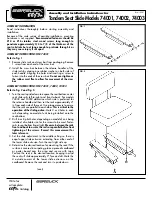
14
Section 1 - Safety Information
WARNING
MOST HIGH PRESSURE WATERBLASTING OPERATIONS
PRODUCE NOISE LEVELS THAT EXCEED 90 DB WHICH CAN
CAUSE PERMANENT HEARING LOSS.
A L L O P E R ATO R S A N D S U P P O R T P E R S O N N E L M U S T
WEAR EAR PROTECTION IN ACCORDANCE WITH OSHA
STANDARDS AND PROVISIONS SHOULD BE MADE FOR
REGULAR INSPECTION AND MAINTENANCE.
REMEMBER: ULTRA-HIGH PRESSURE BLASTING CAN
CAUSE DEBRIS TO BE PROJECTED UNEXPECTEDLY IN
AND AROUND THE WORK AREA THAT CAN CAUSE SEVERE
INJURY. MAKE SURE ALL PERSONNEL STAY WELL CLEAR
OF THE BLASTING AREA AND USE HARD HATS, EYE AND
EAR PROTECTION.
1.3 Nozzle Safety
Check Flow Rating
Combined nozzle flow rate must be compatible
with the pump discharge and pressure rating.
Refer to the nozzle flow chart in this manual.
Check Pressure Rating
Use only nozzles with a manufacturer’s pressure
rating of at least the pump’s operating pressure
or a burst rating of no less than 60,000 psi (4,137
BAR.)
Check Orifices
Prior to installation, make sure the nozzles have
no clogged orifices. Also, check to ensure nozzles
are sharp and not excessively worn.
Check Connections
Be sure to never force a nozzle into the blasting
head. Clean threads to ensure nozzle is not cross-
threading. Use an ample amount of anti-seize
on threads only, never on the seat of the nozzle.
Inspect the seat area on nozzle to ensure a tight
seal. If it is damaged, do not use.
Clogged Nozzles
If a nozzle appears clogged, immediately disen-
gage pump. Remove any clogged nozzles and
replace with new nozzles. Any particles of the
smallest size will clog nozzles. Clogged nozzles
can create excessive pressure in pump.
Remove Nozzle from Service if:
A) Nozzle is split or damaged.
B) Nozzle is clogged.
C) Nozzle water spray is fanned out.
D) Nozzle’s ability to hold pressure is suspect.
E) Nozzle’s hex head is worn excessively from
blasting.
F) Nozzle threads are damaged.
1.4 Hose Safety
General
Ultra-High Pressure hoses are tough, but not in-
vincible. They require proper care and handling
to achieve the normal service life of 300 - 600
hours. If the hoses are abused, the service life
will be much shorter.
Stretched or abused hose can fail prematurely
and unexpectedly, which could cause injury to
personnel. Hoses that have been exposed to
excessive stretching or kinks should be removed
from service and discarded.
Check Connections
Check the condition of the connection threads
prior to connecting any fittings or hoses. Use an
anti-seize compound on all fittings and hoses
to prevent “galling,” as galling will destroy the
threads, fittings and/or hose ends.
Tighten Connections
Properly tighten all high pressure connections.
Usually, snug plus a 15% tightening will properly
seal connections.
Take Proper Care of Your Hose
A) Protect the hose from contact with sharp
objects, abrasive surfaces and foot or wheel
traffic.
B) Never subject Ultra-High Pressure hose to a
tight radius (less than 30” (.8 m) or pull on a
coiled hose. Always make sure the hoses are
straight with no coils before pulling on the hose
to deploy it.
Summary of Contents for STRIPE SH7500
Page 1: ...75 H Operations Manual...
Page 2: ......
Page 72: ...72 NOTES...
Page 108: ...108 NOTES...
Page 161: ...161 Section 5 Scheduled Maintenance...
Page 167: ...167 Appendix 2 Tools Spare Parts...
Page 168: ...168 Appendix 2 Tools Spare Parts...
Page 169: ...169 Appendix 3 Daily Report Pre Op Checklist 1 877 HOG ROAD WWW STRIPEHOGSUPPORT COM 60...
Page 178: ...178 NOTES...
Page 185: ......
Page 186: ......















































